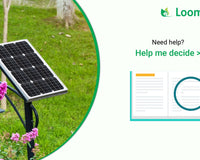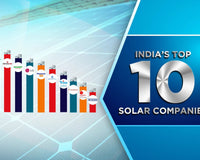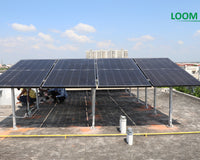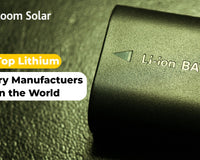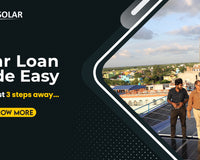There are always some ways to do things with ease of moment and without need of a specialist. Today’s write up is a very special one as we have got you, in this article we have given some DIY (Do It Yourself) steps on a very searched question i.e., “How to connect solar panels to battery?’We have mentioned all the ways in small and easy steps, to shorten the process.
Step 1: Battery Technology
Before heading towards the step guide, we must understand the technology type of a battery and how do they work.
a. Lead Acid Battery: A lead-acid battery is a rechargeable battery that stores electrical energy through a chemical reaction involving lead, lead oxide, and sulfuric acid. Commonly used in automobiles, UPS systems, and solar power storage, these batteries are known for their reliability and cost-effectiveness. While they can deliver high surge currents, they are relatively heavy and have a limited energy-to-weight ratio compared to other battery types. Regular maintenance is crucial for their longevity and performance.
b. Lithium Ion Battery: A lithium-ion battery is a rechargeable battery that stores electrical energy using lithium ions. It consists of a lithium cobalt oxide cathode, a graphite anode, and an electrolyte solution. Lithium-ion batteries are widely used in various electronic devices like smartphones, laptops, and electric vehicles due to their high energy density, lightweight, and longer lifespan compared to other battery types. They have revolutionized portable electronics and are crucial for the advancement of renewable energy and electric transportation.
Step 2: Application
Now let us understand the application of wiring and its formats –
*(Note – DC, AC are the types of current which stands for Direct Current and Alternate Current. These formats are used in wiring as well.)
DC to DC Solution: To connect a DC solar panel to a DC battery, use a charge controller. Connect the positive (+) terminal of the solar panel to the positive (+) terminal of the battery and the negative (-) terminal of the solar panel to the negative (-) terminal of the battery. The charge controller regulates the charging process, preventing overcharging and protecting the battery. Ensure proper cable sizing and secure connections for efficient and safe operation.
DC to AC Solution: To connect a DC solar panel to an AC battery system, you will need an inverter. Connect the positive (+) terminal of the solar panel to the positive (+) terminal of the inverter and the negative (-) terminal of the solar panel to the negative (-) terminal of the inverter. Then, connect the output terminals of the inverter to the AC battery. The inverter converts the DC power from the solar panel to AC power, which can be stored in the AC battery.
Step 3: Solar Panel Specification
12 V or 24 V: In simple terms, 12V or 24V in a solar panel refers to the power it can produce. A 12V solar panel can generate around 17-18 volts of electricity during sunny times. It's used for smaller things like charging small batteries or powering small devices like lights and fans. On the other hand, a 24V solar panel can produce around 34-36 volts during sunny times. It's used for bigger things like charging larger batteries or powering bigger appliances and systems. Choosing the right voltage is important to make sure the solar panel works well with the batteries and devices you want to use.
Step 4: Wiring Connection Process
Battery Wire (DC Wire)
There are multiple cases with the wiring connection. We have defined all the possible wiring connection.
-
For a 12V Solar Inverter –
No series connection is required. -
For a 24V Solar Inverter –
Connect two 12V batteries in series (positive to negative) to create a 24V connection. A series connection can be defined as a flow of charge from Positive (+) to Negative (-). - For a 48V Solar Inverter –
Connect four 12V batteries in series to make a 48V connection. This series connection is only required for a lead acid battery. However, for lithium batteries, no series connection is needed.
Connection between Battery and Inverter or Charge Controller
Now let us understand the connection process between an inverter to a battery or a charge controller –
For DC-to-DC (Direct Current to Direct Current) setup: Connect the battery to the charge controller by attaching the positive and negative wires.
For DC-to-AC (Direct Current to Alternate Current) setup: Connect the battery to the solar inverter. In smaller solar systems (up to 2 kW), you can directly link the solar battery to the inverter. But for higher capacity systems, connect the battery wire to a DC MCB (Direct Current Miniature Circuit Breakers) first, then attach it to the inverter. For 3 kW solar inverters, you have the option to connect the battery wires on the MCB. Remember to shut down all MCBs during the wiring process. Once the battery and inverter are connected, you can connect the solar panels to the inverter or charge controller.
Connection between Solar Panel and Inverter or Charge Controller
For a DC-to-DC (Direct Current to Direct Current) system: Connect the solar panel's positive and negative wires to the charge controller.
For a DC-to-AC (Direct Current to Alternate Current) system: Connect the solar panel wiring to the solar inverter. In small solar setups, use one DC MCB (Direct Current Miniature Circuit Breakers) to control the PV (photovoltaic) voltage. This works well for systems up to 2 kW. However, for larger systems, you will need a DCDB suitable for the inverter capacity. DCDB (Direct Current Distribution Box) comes in different types like 4-in-2-out or 4-in-1-out. To connect the solar panels properly, you will need the installation tools. Using these tools, you can set up the wiring correctly and ensure everything works as it should. Always note that while performing these listed tasks, stay very careful with the solar panels, its components and with the handling of electricity to prevent any mis happenings.
Conclusion
We hope that this article has provided you with the much required information that you have been wanting to install solar panels and wire the connections. We hope that you like the information that we have gathered for you. To know more about such interesting information and facts, keep following us.






